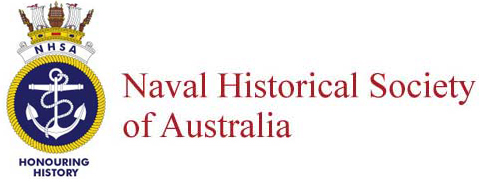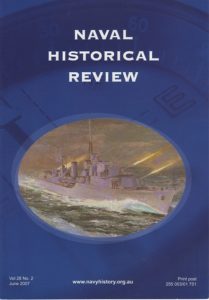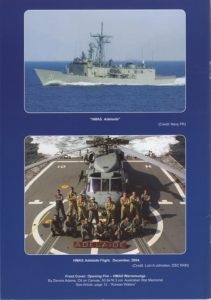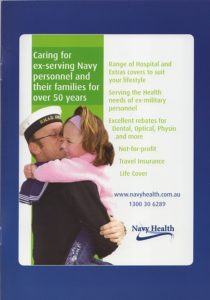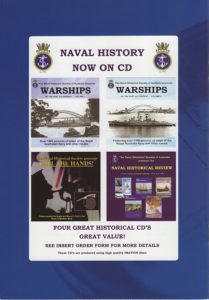- Author
- Editorial Staff
- Subjects
- Ship histories and stories, WWII operations, History - WW2
- Tags
-
- RAN Ships
- HMAS Maryborough
- Publication
- June 2024 edition of the Naval Historical Review (all rights reserved)
An email was received recently from Ian Gotts of St Albans in England about the wartime exploits of his cousin Able Seaman James Gotts who was rescued from HMS Electra, sunk in the Battle of the Java Sea. The Electra story itself is praiseworthy; suffice to say she arrived in Singapore with HM Ships Prince of Wales and Repulse and rescued 571 men from these ships. In the subsequent Battle of the Java Sea she fought valiantly but was sunk, and many of her crew perished. Some 54 officers and men were rescued by the USN Submarine S-38 (LCDR Henry Munson USN) and taken to the Dutch naval base at Surabaya in east Java; while one died the remainder were eventually taken by train to Tjilatjap on the south coast of Java.
The Royal Navy’s 21st Minesweeping Flotilla based on Singapore comprised seven Australian built corvettes. These were HMA Ships Ballarat, Bendigo, Burnie, Goulburn, Maryborough, Toowoomba and Wollongong. The Flotilla was led by Maryborough under Commander Glen Cant RAN, who had previously commanded HMAS Vendetta, one of the famous ‘Scrap-Iron Flotilla’ in the Mediterranean.
The early days at Singapore were carefree; conducting anti-submarine patrols at the entrance to the Johore Straits on eight-day patrols followed by four days alongside under the boom protecting Singapore harbour. These times came to an end in early December 1941 with the arrival of the mighty battleship HMS Prince of Wales and the battlecruiser HMS Repulse accompanied by the destroyers HM Ships Eclipse, Electra and Jupiter. Days later the war in the Pacific began with attacks on Pearl Harbour, the Philippines and Singapore, and the pride of the Royal Navy, Prince of Wales and Repulse lying at the bottom of the South China Sea.
The situation in Malaysia quickly deteriorated leading to the fall and evacuation from this great fortress but with many left behind ending up in captivity. The war moved to the adjacent Netherlands East Indies (NEI) with naval battles in the Banka Strait, Java Sea and Sunda Strait, tragically all Allied disasters. But throughout this period the 21st Minesweeping Flotilla survived and towards the final evacuation of Allied forces from the NEI the Flotilla had congregated at Tjilatjap, the last place they could find fuel.
Tjilatjap was the last hope and collection point for British, Dutch and Commonwealth personnel trying to escape the Japanese invasion. Dutch records indicate the harbour was overflowing with merchant and naval ships trying to escape and repatriate civil and military personnel. The evacuation started in earnest on 27 February when ships were ordered to disperse. Of 24 ships with evacuees that departed Tjilatjap only 13 reached their destinations either in SRI Lanka or West Australia. Most ships took the calculated gamble of independent passage without escort. Given the chaotic conditions it is difficult to estimate how many personnel were evacuated and the number who survived.
Ships departing Tjilatjap with evacuees bound for Fremantle – late Feb to early March 1942
| Ship | Tonnage | Depart Date | Arrive Date | No. Evacuees |
| Abbekerk | 7906 | 27 Feb 1942 | 4 March 1942 | 1500 |
| General Verspyck | 1213 | 2 March 1942 | 10 March 1942 | 250 |
| Janseens | 1492 | 4 March 1942 | 13 March 1942 | 200 ? |
| Kheon Hoea | 1 March 1942 | 7 March 1942 | 150 | |
| Sloterdijk | 9230 | 2 March 1942 | 8 March 1942 | 350 |
| Tjimanoek | 5628 | 15 March 1942 | 14 | |
| Tung Song | 549 | 2 March 1942 | 13 March 1942 | 205 |
| Zaandam | 10,909 | 27 Feb 1942 | 7 March 1942 | 950 |
The above provides a total of 3619 evacuees plus those carried by the seven vessels from the 21st Minesweeping Flotilla of about 80 each (560) giving a grand total of about 4179 rescued. It is assumed a similar number may have reached Colombo. However, many thousands were left behind to an uncertain future as prisoners of war.
All these vessels, both commercial and naval, were proceeding into a region of great peril with Japanese ships, submarines and aircraft on the prowl looking for likely targets. This was the case with HMAS Yarra and HMS Strongholdand their convoys, which fell victim to enemy action.
Bendigo was the first of the minesweepers to leave on 1 March 1942 with 10 ABDA staff from the office of Commodore John Collins RAN; she also took aboard one RAF officer, one civilian and 77 survivors from HMS Jupiter.Amongst the last to leave in Burnie with an influx of passengers which included Captain Leonard Bell RN, the commanding officer of the doomed Prince of Wales, and CDRE John Collins RAN.
British authorities also chartered four Dutch ships; amongst these was an old colonial coal burner, the 1213 ton General Verspyck of the Koninkleike Paketvaart Maatschappij (KPM) line which was deserted by most of her crew. Local officials agreed to her being manned by Royal Naval personnel with 149 coming forward under Commander E.R.A. Farquharson RN. The ship was still commanded by her KPM master, assisted by three of his officers.
In addition, the ship took on the British Consul General and Major Charles Moses (later Sir Charles Moses, Chairman of the Australian Broadcasting Commission), 45 survivors from Electra, LEUT Arthur Mann RNVR a survivor from the ill-fated SS Vyner Brook, 30 British civilians, a number of Dutch civilians, 13 USN personnel and five American civilians – a total of over 250 personnel. The senior naval officer ashore at this time, Commodore Collins, authorised the ship to sail at 2245 on 2 March 1942 in company with Maryborough.
One day out they were attacked by a Japanese floatplane dropping its two 100 pound bombs which thankfully missed; she was scared off by Maryborough’s AA pom poms and did not return. With the threat of air attack the poor old SS General Verspyck with her scratch crew of stokers, including Major Charles Moses – a fine sportsman doing his bit, had only been making four knots. After strong words of encouragement from Maryborough’s captain, suddenly Verspyck with black smoke belching everywhere put on an impressive 10 knots overtaking her escort. The ships then safely reached Fremantle on 10 March and survivors were initially taken to HMAS Leeuwin before being returned to their units.
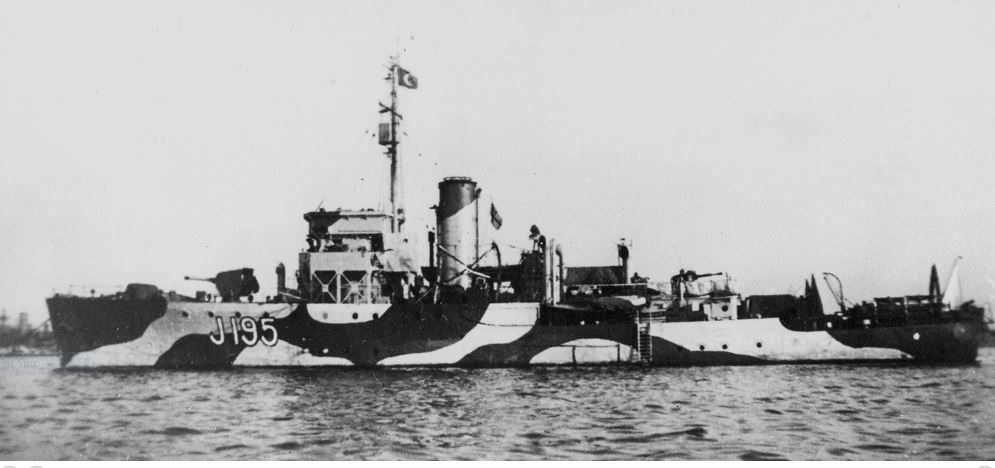
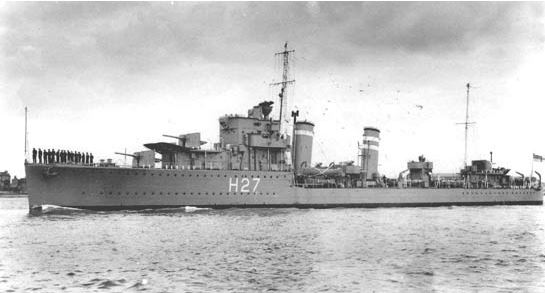
Summary
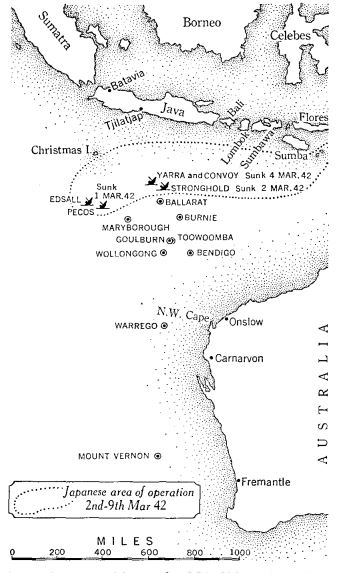
The fall of Singapore followed by the loss of the Netherland East Indies were some of the darkest days in Australian history. Everywhere the enemy was advancing and we seemed unable to stem the tide. The war was brought close to our doors when on 3 March Japanese air raids from Timor strafed the towns of Broome and Wyndham where a moored squadron of flying boats was destroyed. Japanese warships roamed with impunity and with their submarines they harried Allied shipping off the north-west coast of the continent. Safe havens such as Fremantle allowed us to consolidate, and thanks to those gallant few who escaped from Tjilatjap we were able to fight again on another day.
References:
Ogle, Brian, The History of HMAS Maryborough, Self- published, Wahroonga, NSW, 1992.
Ogle, Brian, Moses in the Stokehold, Naval Historical Review, Sydney, December 2001.
Ford, Jack, The Floating Dutchmen – The Netherlands Merchant Navy in the Pacific War, Journal of Australian Navy History, Vol 6 No 1, Naval Historical Society, Sydney, March 2009.
Walker, Frank, B, Corvettes – Little Ships for Big Men, Kingfisher Press, Budgewoi, NSW, 1995.
Womack, Tom, The Allied Defense of the Malay Barrier 1941-1942, McFarland & Co Inc., Jefferson, North Carolina, 1967.
